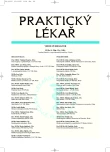Osteoarthritis – some new aspects of this disease
Osteoartróza – nové pohledy na toto onemocnění
V přehledném referátu je pojednáno o některých novějších pohledech na patogenezi osteoartrózy. Osteoartróza byla doposud vnimána jako primární onemocnění kloubní chrupavky. V poslední době se poukazuje na to, že u osteoartrózy je chrupavka spíše druhotnou „obětí“ změn v dalších tkáních kloubních a mimokloubních, které ovlivní biomechaniku kloubu a integritu chrupavky. Patří mezi ně změny subchondrální kosti, kloubních ligament, kolemkloubních svalů, menisků, poruchy propriocepce a synovitis. Nepominutelnou roli hraje i obezita, a to nejenom mechanobiologickým účinkem, ale i produkcí mediátorů, které zasahují do anabolických a katabolických procesů v chrupavce.
Klíčová slova:
osteoartróza, patogeneze, úloha kloubních a mimokloubních tkání.
Authors:
K. Trnavský
Authors‘ workplace:
Ředitel: MUDr. Antonín Malina Ph. D. MBA
; Vedoucí lékař prof. MUDr. K. Trnavský, DrSc.
; Institut postgraduálního vzdělávání ve zdravotnictví, Praha
; Arthrocentrum Praha
Published in:
Prakt. Lék. 2007; 87(4): 216-218
Category:
Various Specialization
Overview
This review presents some new pathogenetic aspects of osteoarthritis. Osteoarthritis has been thought of as a primary disease of cartilage. Studies over the past several years, however, have shown that articular cartilage is a secondary “victim” of pathological changes in other articular and extra-articular tissues which affect the biomechanics and integrity of the cartilage. These tissues include subchondral bone, articular ligaments, periarticular muscles, menisci, sensory nerve endings and synovitis. Obesity plays an important role, not only through its mechanobiological effects, but also through the production of certain mediators by adipose tissue, which affect catabolic and anabolic processes in cartilage.
Key words:
osteoarthritis, pathogenesis, role of articular and extra-articular tissues.
Labels
General practitioner for children and adolescents General practitioner for adultsArticle was published in
General Practitioner

2007 Issue 4
- What Effect Can Be Expected from Limosilactobacillus reuteri in Mucositis and Peri-Implantitis?
- Spasmolytic Effect of Metamizole
- Metamizole at a Glance and in Practice – Effective Non-Opioid Analgesic for All Ages
- Advances in the Treatment of Myasthenia Gravis on the Horizon
Most read in this issue
- Todays trends of diagnostics and treatment of scaphoid bone fractures
- Extensive trombosis of thoracic aorta – an unusual source of acute peripheral arterial embolism.
- Epileptic fit as a syncope equivalent in severe aortic stenosis.
- Smoking and skin
